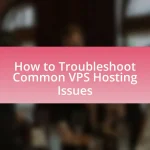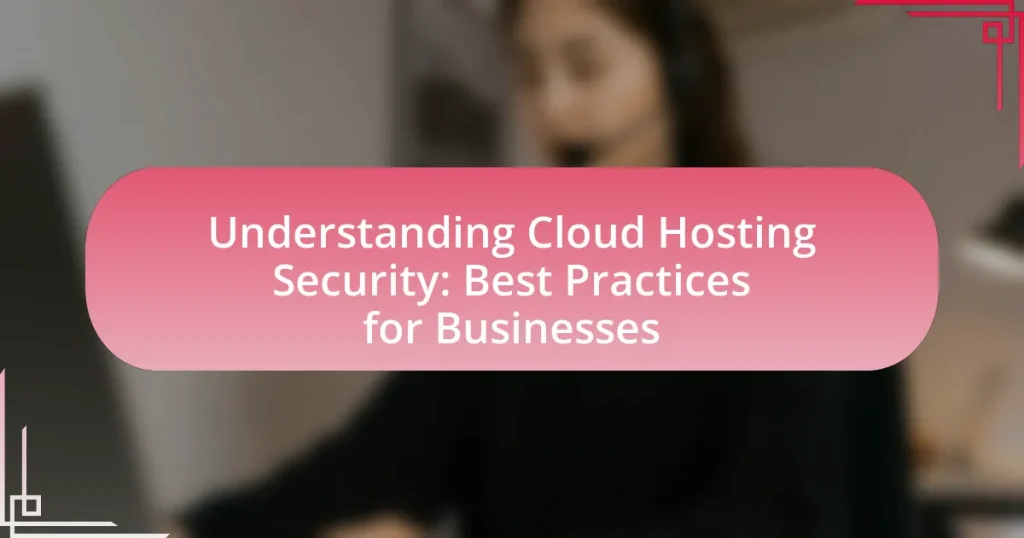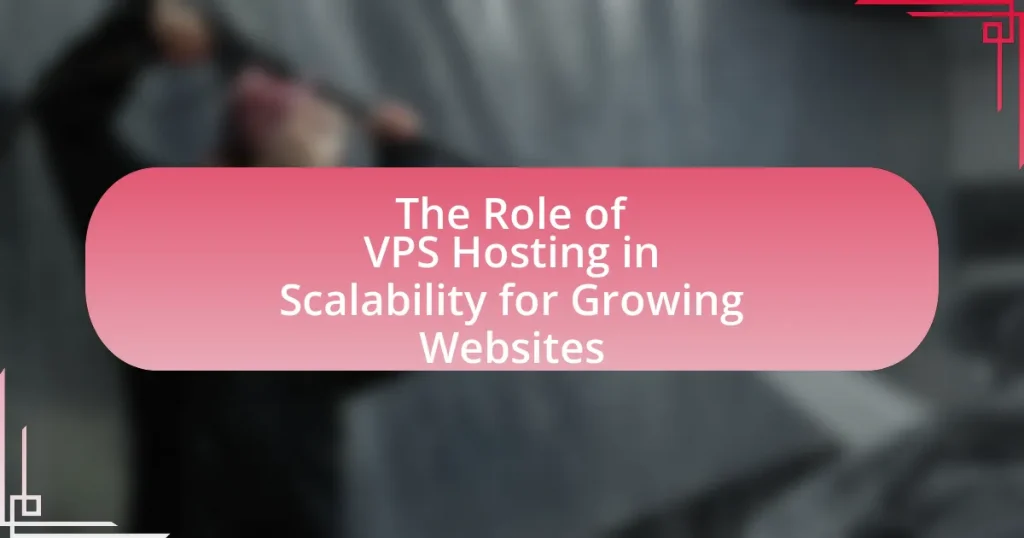Cloud hosting security encompasses the measures and protocols designed to protect data, applications, and infrastructure within cloud environments. This article outlines the differences between cloud hosting security and traditional hosting security, emphasizing the importance of scalability and shared responsibility. Key components such as data encryption, access controls, and incident response strategies are discussed, along with common threats like data breaches and insider threats. Best practices for enhancing cloud security, including strong access controls and regular security audits, are highlighted, providing businesses with essential insights to safeguard their cloud environments effectively.
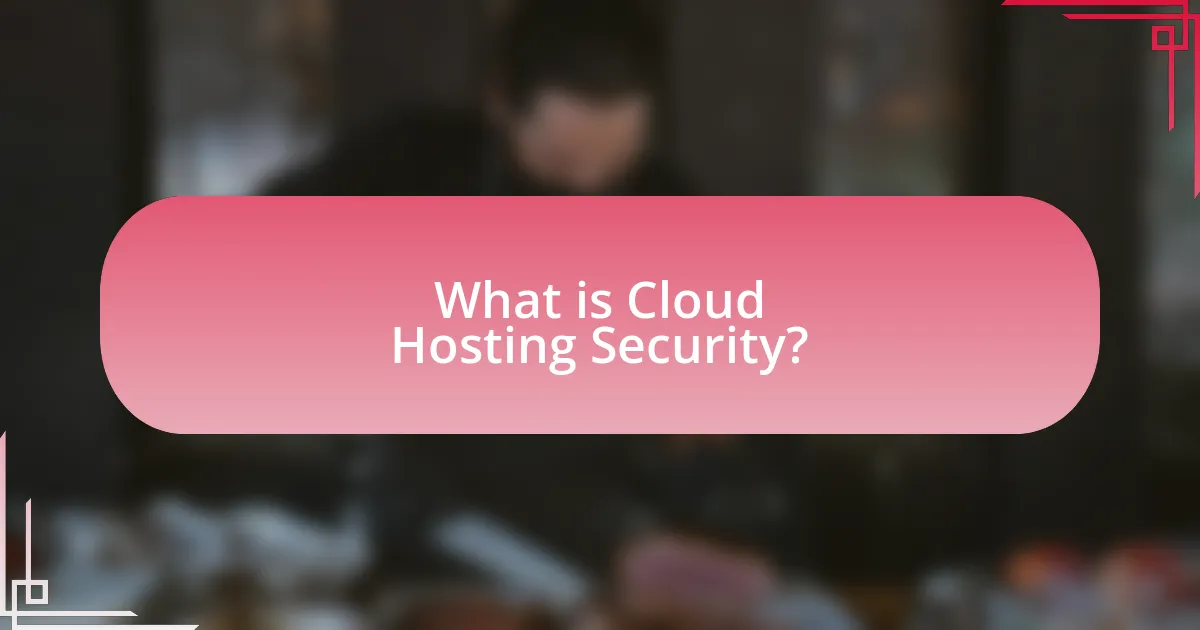
What is Cloud Hosting Security?
Cloud hosting security refers to the measures and protocols implemented to protect data, applications, and infrastructure hosted in the cloud environment. This security encompasses various aspects, including data encryption, access controls, and regular security audits, to safeguard against unauthorized access, data breaches, and other cyber threats. According to a report by McAfee, 52% of organizations experienced a cloud security incident in the past year, highlighting the critical need for robust security practices in cloud hosting.
How does Cloud Hosting Security differ from traditional hosting security?
Cloud hosting security differs from traditional hosting security primarily in its scalability and resource distribution. In cloud hosting, security measures are often integrated at multiple levels, including the physical, network, and application layers, leveraging a shared responsibility model where both the provider and the user play roles in maintaining security. Traditional hosting typically relies on a single server or a limited set of servers, which can create vulnerabilities if not properly managed.
For instance, cloud providers often implement advanced security protocols such as automated threat detection and response, which can adapt to evolving threats more effectively than traditional hosting setups. According to a 2021 report by the Cloud Security Alliance, 94% of organizations reported improved security after migrating to the cloud, highlighting the enhanced security capabilities that cloud environments can offer compared to traditional hosting.
What are the key components of Cloud Hosting Security?
The key components of Cloud Hosting Security include data encryption, access control, network security, compliance, and incident response. Data encryption protects sensitive information both at rest and in transit, ensuring that unauthorized users cannot access it. Access control mechanisms, such as multi-factor authentication and role-based access, restrict user permissions and enhance security. Network security measures, including firewalls and intrusion detection systems, safeguard the cloud infrastructure from external threats. Compliance with regulations like GDPR and HIPAA ensures that businesses adhere to legal standards for data protection. Finally, an effective incident response plan enables organizations to quickly address and mitigate security breaches, minimizing potential damage. These components collectively create a robust security framework for cloud hosting environments.
Why is Cloud Hosting Security essential for businesses?
Cloud Hosting Security is essential for businesses because it protects sensitive data from cyber threats and ensures compliance with regulations. With the increasing frequency of data breaches, businesses face significant risks, including financial loss and reputational damage. According to a report by IBM, the average cost of a data breach in 2023 was $4.45 million, highlighting the financial implications of inadequate security measures. Furthermore, cloud hosting security measures, such as encryption and access controls, help businesses safeguard their information and maintain customer trust, which is vital for long-term success.
What are the common threats to Cloud Hosting Security?
Common threats to cloud hosting security include data breaches, account hijacking, insecure APIs, and denial-of-service attacks. Data breaches occur when unauthorized individuals gain access to sensitive information stored in the cloud, often due to weak security measures or vulnerabilities. Account hijacking involves attackers taking control of user accounts, typically through phishing or credential theft, which can lead to unauthorized access to cloud resources. Insecure APIs can expose cloud services to attacks if not properly secured, allowing malicious actors to exploit vulnerabilities. Denial-of-service attacks aim to overwhelm cloud services, rendering them unavailable to legitimate users. According to the 2021 Cloud Security Report by Cybersecurity Insiders, 93% of organizations experienced a cloud security incident in the past year, highlighting the prevalence of these threats.
How do data breaches occur in cloud environments?
Data breaches in cloud environments occur primarily due to inadequate security measures, misconfigurations, and vulnerabilities in cloud services. For instance, research by the Cloud Security Alliance indicates that 64% of cloud security incidents are attributed to misconfigured cloud settings, which expose sensitive data to unauthorized access. Additionally, weak access controls and compromised credentials can lead to unauthorized users gaining access to cloud resources, further increasing the risk of data breaches. Furthermore, vulnerabilities in third-party applications integrated with cloud services can also serve as entry points for attackers, as highlighted in the Verizon Data Breach Investigations Report, which shows that 30% of breaches involve third-party vendors.
What role do insider threats play in Cloud Hosting Security?
Insider threats significantly undermine Cloud Hosting Security by exploiting access privileges to compromise sensitive data and systems. These threats can originate from employees, contractors, or business partners who intentionally or unintentionally misuse their access to cloud resources. According to a report by the Ponemon Institute, 60% of data breaches involve insider threats, highlighting the critical need for robust security measures. Effective strategies to mitigate these risks include implementing strict access controls, continuous monitoring of user activities, and regular security training for employees to recognize and report suspicious behavior.
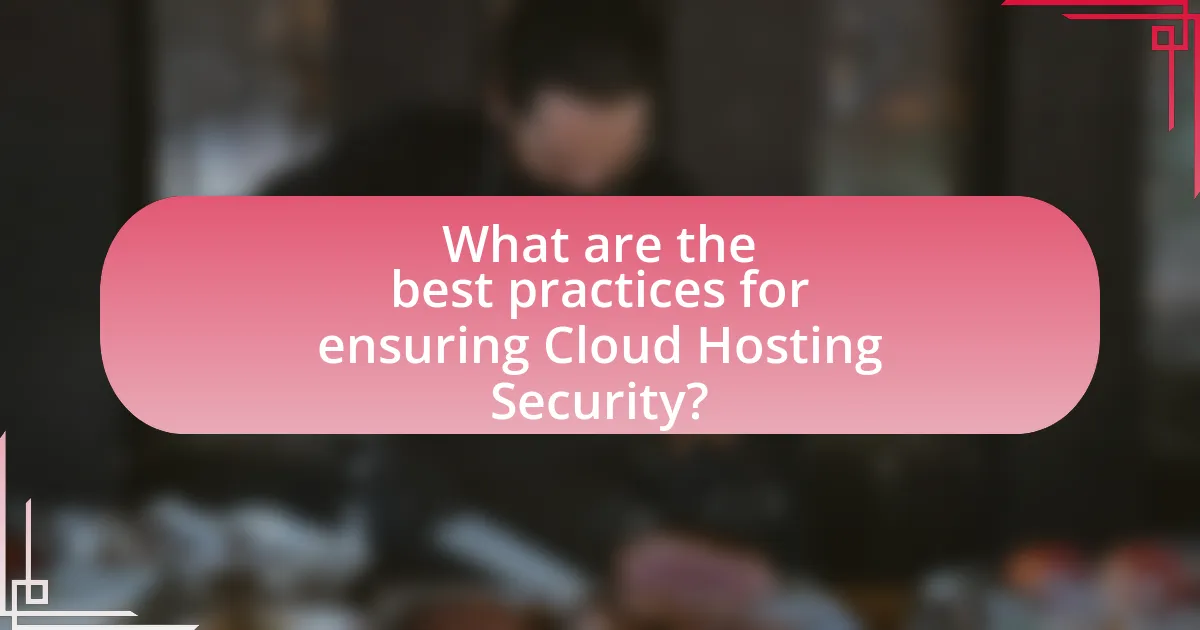
What are the best practices for ensuring Cloud Hosting Security?
The best practices for ensuring Cloud Hosting Security include implementing strong access controls, utilizing encryption, regularly updating software, and conducting security audits. Strong access controls, such as multi-factor authentication, limit unauthorized access to cloud resources. Encryption protects data both in transit and at rest, making it unreadable to unauthorized users. Regular software updates address vulnerabilities and enhance security features, while security audits help identify and mitigate potential risks. According to a 2021 report by the Cloud Security Alliance, 64% of organizations experienced a cloud security incident, highlighting the importance of these practices in safeguarding cloud environments.
How can businesses implement strong access controls?
Businesses can implement strong access controls by adopting a multi-layered approach that includes role-based access control (RBAC), strong authentication methods, and regular audits. RBAC ensures that employees have access only to the information necessary for their roles, minimizing the risk of unauthorized access. Strong authentication methods, such as multi-factor authentication (MFA), add an additional layer of security by requiring users to provide multiple forms of verification before accessing sensitive data. Regular audits help identify and rectify any access control weaknesses, ensuring compliance with security policies. According to a 2021 report by the Ponemon Institute, organizations that implement RBAC and MFA significantly reduce the likelihood of data breaches, demonstrating the effectiveness of these strategies in enhancing security.
What are the different types of access controls available?
The different types of access controls available include discretionary access control (DAC), mandatory access control (MAC), role-based access control (RBAC), and attribute-based access control (ABAC). DAC allows users to control access to their own resources, while MAC enforces access policies based on classifications and security levels. RBAC assigns access rights based on user roles within an organization, and ABAC grants access based on attributes of users, resources, and the environment. These access control models are essential for managing permissions and enhancing security in cloud hosting environments.
Why is multi-factor authentication important?
Multi-factor authentication is important because it significantly enhances security by requiring multiple forms of verification before granting access to sensitive information. This method reduces the risk of unauthorized access, as even if one factor, such as a password, is compromised, additional factors like a text message code or biometric verification are still needed. According to a report by the Cybersecurity & Infrastructure Security Agency, implementing multi-factor authentication can block up to 99.9% of automated cyber attacks, demonstrating its effectiveness in protecting against data breaches and identity theft.
What encryption methods should be used for cloud data?
The encryption methods that should be used for cloud data include Advanced Encryption Standard (AES), RSA (Rivest-Shamir-Adleman), and Transport Layer Security (TLS). AES is widely recognized for its efficiency and security, utilizing key sizes of 128, 192, or 256 bits, making it suitable for encrypting large volumes of data in the cloud. RSA, a public-key encryption method, is essential for secure key exchange and digital signatures, ensuring that data remains confidential during transmission. TLS provides a secure channel over the internet, protecting data in transit between the user and the cloud service provider. These methods are validated by their widespread adoption in industry standards, such as the National Institute of Standards and Technology (NIST) guidelines, which recommend AES for encrypting sensitive information.
How does encryption protect sensitive information?
Encryption protects sensitive information by converting it into a coded format that is unreadable without a decryption key. This process ensures that even if unauthorized individuals access the data, they cannot interpret it without the necessary credentials. For instance, the Advanced Encryption Standard (AES) is widely used and recognized for its effectiveness in securing data, as it employs complex algorithms that make unauthorized decryption practically infeasible. According to the National Institute of Standards and Technology (NIST), encryption is a critical component of data security protocols, significantly reducing the risk of data breaches and unauthorized access.
What are the best practices for managing encryption keys?
The best practices for managing encryption keys include implementing a robust key management system, regularly rotating keys, and ensuring keys are stored securely. A key management system centralizes the generation, storage, and distribution of keys, reducing the risk of unauthorized access. Regular key rotation minimizes the impact of a compromised key, as it limits the time an attacker can exploit it. Secure storage methods, such as hardware security modules (HSMs) or cloud-based key management services, protect keys from unauthorized access and physical theft. According to the National Institute of Standards and Technology (NIST), following these practices can significantly enhance the security of cryptographic systems.
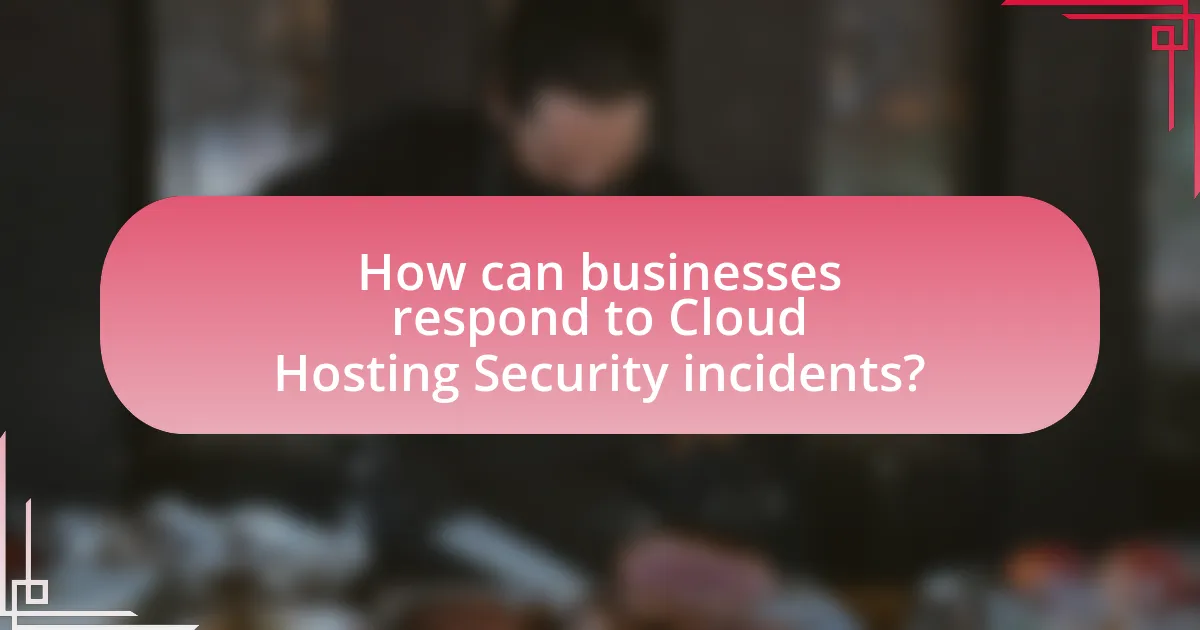
How can businesses respond to Cloud Hosting Security incidents?
Businesses can respond to Cloud Hosting Security incidents by implementing a structured incident response plan that includes immediate containment, investigation, and remediation steps. This plan should involve identifying the nature of the incident, assessing the impact on data and services, and notifying affected stakeholders as per compliance requirements. According to the Ponemon Institute’s 2021 Cost of a Data Breach Report, organizations with an incident response team can reduce the cost of a breach by an average of $2 million. Therefore, having a dedicated team and established protocols is crucial for effective response and minimizing damage.
What steps should be taken in the event of a security breach?
In the event of a security breach, the first step is to contain the breach to prevent further unauthorized access. This involves isolating affected systems and disabling compromised accounts. Next, organizations should assess the extent of the breach by identifying what data was accessed or stolen, which can be done through logs and monitoring tools. Following this, it is crucial to notify affected parties, including customers and regulatory bodies, as required by laws such as GDPR or HIPAA, which mandate timely disclosure of breaches.
After notification, organizations should conduct a thorough investigation to understand the cause of the breach, which may involve forensic analysis. Once the investigation is complete, implementing remediation measures is essential to address vulnerabilities and prevent future incidents. This may include updating security protocols, enhancing employee training, and applying patches to software. Finally, documenting the incident and the response taken is vital for compliance and future reference.
How can incident response plans be developed and tested?
Incident response plans can be developed by identifying potential security incidents, defining roles and responsibilities, and establishing procedures for detection, response, and recovery. The development process involves conducting a risk assessment to understand vulnerabilities and threats, followed by creating a documented plan that outlines specific actions to take during an incident. Testing these plans is essential and can be achieved through tabletop exercises, simulations, and live drills that evaluate the effectiveness of the response strategies and team readiness. Regular reviews and updates of the incident response plan ensure it remains relevant and effective against evolving threats.
What role does communication play during a security incident?
Communication is critical during a security incident as it ensures timely information sharing, coordination among response teams, and transparency with stakeholders. Effective communication facilitates rapid decision-making, minimizes confusion, and helps maintain trust with customers and partners. For instance, a study by the Ponemon Institute found that organizations with effective communication strategies during incidents can reduce the average cost of a data breach by approximately $1.2 million. This highlights the importance of clear and structured communication in mitigating the impact of security incidents.
What tools and technologies can enhance Cloud Hosting Security?
Tools and technologies that can enhance Cloud Hosting Security include firewalls, encryption, intrusion detection systems, and multi-factor authentication. Firewalls protect cloud environments by filtering incoming and outgoing traffic based on security rules, while encryption secures data both at rest and in transit, making it unreadable to unauthorized users. Intrusion detection systems monitor network traffic for suspicious activity, providing alerts for potential breaches. Multi-factor authentication adds an additional layer of security by requiring users to provide two or more verification factors to gain access, significantly reducing the risk of unauthorized access. These tools collectively strengthen the security posture of cloud hosting environments, ensuring data integrity and confidentiality.
How do firewalls and intrusion detection systems work in the cloud?
Firewalls and intrusion detection systems (IDS) in the cloud function by monitoring and controlling incoming and outgoing network traffic based on predetermined security rules. Firewalls act as a barrier between trusted internal networks and untrusted external networks, filtering traffic to prevent unauthorized access. They can be implemented as hardware or software solutions and are essential for establishing a secure perimeter around cloud resources.
Intrusion detection systems complement firewalls by analyzing network traffic for suspicious activity and potential threats. IDS can be host-based or network-based, with host-based systems monitoring individual devices and network-based systems analyzing traffic across the entire network. When a potential threat is detected, the IDS can alert administrators or take automated actions to mitigate the risk.
The effectiveness of firewalls and IDS in the cloud is supported by their ability to adapt to dynamic environments, providing real-time protection against evolving threats. According to a report by Gartner, organizations that implement layered security measures, including firewalls and IDS, can reduce the risk of data breaches by up to 50%. This statistic underscores the importance of these systems in maintaining cloud security.
What are the benefits of using security information and event management (SIEM) tools?
The benefits of using security information and event management (SIEM) tools include enhanced threat detection, improved incident response, and centralized security management. SIEM tools aggregate and analyze security data from various sources, enabling organizations to identify potential threats in real-time. According to a report by Gartner, organizations that implement SIEM solutions can reduce the time to detect and respond to security incidents by up to 50%. Additionally, SIEM tools facilitate compliance with regulatory requirements by providing detailed logs and reports, which are essential for audits. This centralized approach not only streamlines security operations but also enhances overall organizational resilience against cyber threats.
What are the key takeaways for businesses regarding Cloud Hosting Security?
Key takeaways for businesses regarding Cloud Hosting Security include implementing robust access controls, ensuring data encryption, and conducting regular security audits. Access controls limit who can access sensitive information, reducing the risk of unauthorized access; for instance, 81% of data breaches involve weak or stolen passwords, highlighting the importance of strong authentication measures. Data encryption protects information both in transit and at rest, making it unreadable to unauthorized users; according to a report by the Ponemon Institute, organizations that encrypt their data experience 50% fewer breaches. Regular security audits help identify vulnerabilities and ensure compliance with industry standards, as 60% of organizations that conduct audits report improved security posture.
How can businesses continuously improve their Cloud Hosting Security posture?
Businesses can continuously improve their Cloud Hosting Security posture by implementing a multi-layered security strategy that includes regular security assessments, employee training, and adopting advanced security technologies. Regular security assessments, such as vulnerability scans and penetration testing, help identify and mitigate potential threats, ensuring that security measures are up-to-date and effective. Employee training on security best practices is crucial, as human error is a significant factor in security breaches; according to a report by IBM, 95% of cybersecurity breaches are due to human error. Additionally, adopting advanced security technologies like encryption, intrusion detection systems, and automated monitoring tools enhances the overall security framework, providing real-time threat detection and response capabilities. By integrating these practices, businesses can create a robust and adaptive security posture that evolves with emerging threats.
What resources are available for staying updated on Cloud Hosting Security trends?
To stay updated on Cloud Hosting Security trends, professionals can utilize resources such as industry blogs, security forums, and official cloud provider documentation. Notable blogs include the Cloud Security Alliance’s blog, which offers insights on best practices and emerging threats, and the AWS Security Blog, which provides updates on security features and compliance. Additionally, forums like Stack Overflow and Reddit’s r/cloudsecurity allow for community discussions and knowledge sharing. Official documentation from cloud providers like Microsoft Azure and Google Cloud also contains valuable information on security updates and practices. These resources are widely recognized in the industry for their reliability and relevance, making them essential for anyone looking to stay informed on cloud security trends.






